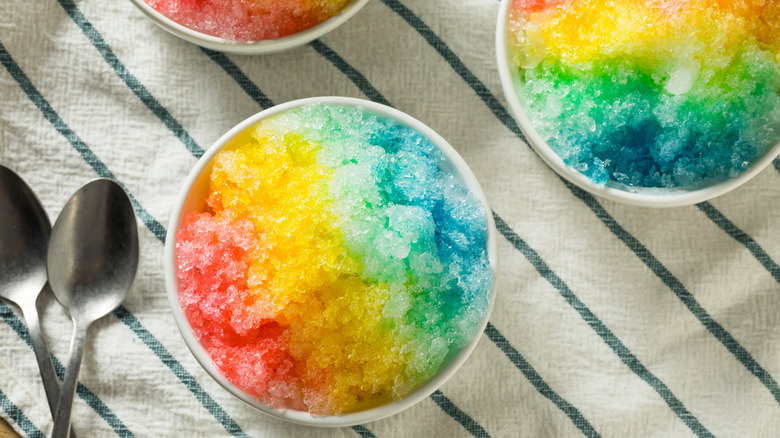The Murky Origin Story Behind The Snow Cone
Flavored ice has been enjoyed for more than a century, but how the idea of forming crushed and shaved ice neatly into cups and cones came to be might be less clear. While several stories provide explanation for ice served in hand-held containers, plenty of treat-eating cultures were shaving ice and flavoring it with an assortment of ingredients long before any ice-shaving machines were invented. In Japan, shaved ice was eaten as early as the 7th century. Immigrants brought what was known as kakigori to Hawaii and covered icy chips with fruit, juice, or sugar. Shaved ice can also be traced to 1100 BC in China, and elite Koreans enjoyed the refreshing treat in the late 1300s with ground nut powder or red bean paste.
From guava-flavored cups of ice found in Puerto Rico to halo halo in the Philippines mixed with purple ube, international recipes for shaved ice could have easily provided the foundation for the American concept of a snow cone. In the 1800s, ice-toting wagons carried blocks of ice to business to keep ingredients cold. The tale is that during hot summer months, East Coast kids would ask these ice-delivery trucks for ice shavings to munch on. In time, a few creative parents added different flavors to the ice, like egg custard made from eggs, vanilla, and sugar.
The icy gift that keeps on giving
An alternative explanation for the development of snow cones pins the location of the first snow cone to the 1919 Texas State Fair. The pioneering vendor Samuel Bert made an ice-crushing machine to sell snow cones and keep his business flourishing. New Orleans also lays claim to the development of snow cones, also locally known as snoballs, thanks to Ernest Hansen and his own ice-shaving enterprise. Hansen wanted to create a cleaner environment for folks to enjoy the treat instead of having to buy flavored ice from a cart to eat on the street. Instead of shaving ice on the road, Hansen opened up an actual storefront where customers could purchase snowballs for two cents. His shop, Hansen's Sno-Bliz, still exists today.
Regardless of who was the first to coat ice pieces in sweet syrup, thanks to these front-runners in the world of flavored icy treats, we can enjoy recipes for an Aperol snow cone and boozy watermelon shaved ice within the comfort of our own homes without having to journey to the roadside to place an order.

